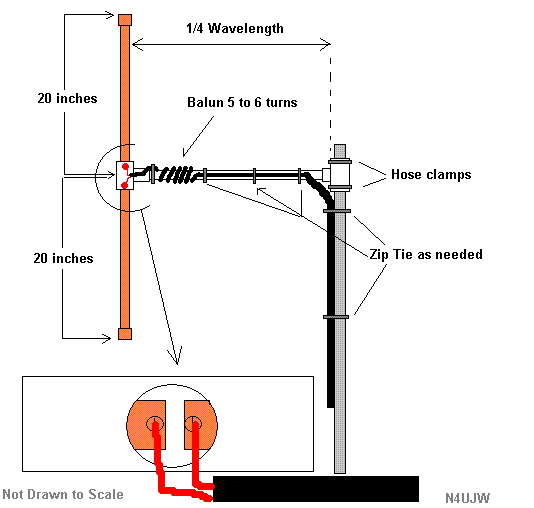


Dalam telekomunikasi, rasio gelombang berdiri (SWR) adalah rasio amplitudo sebuah gelombang berdiri parsial pada suatu titik perut (maksimum) untuk amplitudo pada simpul yang berdekatan (minimal), dalam sebuah saluran transmisi listrik.
SWR ini biasanya didefinisikan sebagai rasio tegangan disebut VSWR, karena rasio gelombang tegangan berdiri. Sebagai contoh, nilai VSWR 1.2:1 menunjukkan gelombang amplitudo maksimum yang berdiri adalah 1,2 kali lebih besar dari nilai minimum gelombang berdiri. Hal ini juga memungkinkan untuk mendefinisikan SWR dalam hal arus, sehingga dalam ISWR, yang memiliki nilai numerik yang sama. Kekuatan gelombang yang berdiri rasio (PSWR) didefinisikan sebagai persegi VSWR.
Praktis implikasi dari SWR
Kasus yang paling umum untuk mengukur dan memeriksa SWR adalah ketika menginstal dan tuning antena transmisi. Ketika pemancar dihubungkan ke antena dengan feed line, impedansi dari antena dan jalur pakan harus sama persis untuk transfer energi maksimum dari garis pakan untuk antena menjadi mungkin. Impedansi dari antena bervariasi berdasarkan banyak faktor termasuk: resonansi alami antena di frekuensi sedang dikirim, tinggi antena di atas tanah, dan ukuran konduktor digunakan untuk membangun antena.
Ketika antena dan feedline tidak memiliki pencocokan impedansi, beberapa energi listrik tidak dapat ditransfer dari feedline ke antena. Energi tidak ditransfer ke antena tercermin kembali ke pemancar. Ini adalah interaksi dari gelombang ini tercermin dengan gelombang maju yang menyebabkan pola gelombang berdiri. Daya Tercermin memiliki tiga implikasi utama di pemancar radio: Radio Frekuensi (RF) kerugian energi meningkat, distorsi pada pemancar karena daya tercermin dari beban dan kerusakan transmitter dapat terjadi Dalam telekomunikasi, rasio gelombang berdiri (SWR) adalah rasio amplitudo sebuah gelombang berdiri parsial pada suatu titik perut (maksimum) untuk amplitudo pada simpul yang berdekatan (minimal), dalam sebuah saluran transmisi listrik.
SWR ini biasanya didefinisikan sebagai rasio tegangan disebut VSWR, karena rasio gelombang tegangan berdiri. Sebagai contoh, nilai VSWR 1.2:1 menunjukkan gelombang amplitudo maksimum yang berdiri adalah 1,2 kali lebih besar dari nilai minimum gelombang berdiri. Hal ini juga memungkinkan untuk mendefinisikan SWR dalam hal arus, sehingga dalam ISWR, yang memiliki nilai numerik yang sama. Kekuatan gelombang yang berdiri rasio (PSWR) didefinisikan sebagai persegi VSWR.
Praktis implikasi dari SWR
Kasus yang paling umum untuk mengukur dan memeriksa SWR adalah ketika menginstal dan tuning antena transmisi. Ketika pemancar dihubungkan ke antena dengan feed line, impedansi dari antena dan jalur pakan harus sama persis untuk transfer energi maksimum dari garis pakan untuk antena menjadi mungkin. Impedansi dari antena bervariasi berdasarkan banyak faktor termasuk: resonansi alami antena di frekuensi sedang dikirim, tinggi antena di atas tanah, dan ukuran konduktor digunakan untuk membangun antena.
Ketika antena dan feedline tidak memiliki pencocokan impedansi, beberapa energi listrik tidak dapat ditransfer dari feedline ke antena. Energi tidak ditransfer ke antena tercermin kembali ke pemancar. Ini adalah interaksi dari gelombang ini tercermin dengan gelombang maju yang menyebabkan pola gelombang berdiri. Daya Tercermin memiliki tiga implikasi utama di pemancar radio: Radio Frekuensi (RF) kerugian energi meningkat, distorsi pada pemancar karena daya tercermin dari beban dan kerusakan transmitter dapat terjadi
Pencocokan impedansi dari antena ke impedansi dari garis pakan biasanya dilakukan dengan menggunakan antena tuner. Tuner dapat diinstal antara pemancar dan feed line, atau antara garis pakan dan antena. Kedua metode instalasi akan memungkinkan transmitter beroperasi pada SWR rendah, namun jika tuner dipasang di pemancar, garis pakan antara tuner dan antena masih akan beroperasi dengan SWR yang tinggi, menyebabkan tambahan energi RF yang akan hilang melalui feedline.
Banyak operator radio amatir ketidakcocokan impedansi mempertimbangkan masalah serius. Namun, hal ini tidak terjadi. Dengan asumsi ketidakcocokan adalah dalam batas-batas operasi dari pemancar, operator radio hanya perlu khawatir dengan kerugian daya dalam saluran transmisi. Rugi daya akan meningkat dengan meningkatnya SWR, namun kenaikan ini sering kurang dari amatir radio mungkin menganggap banyak. Sebagai contoh, sebuah antena dipol disetel untuk beroperasi di 3.75MHz-tengah 80 meter yang amatir radio-band akan pameran SWR sekitar 6:01 di pinggiran band. Namun, jika antena adalah makan dengan 250 kaki coax RG-8A, kerugian akibat gelombang berdiri hanya 2.2dB. Pakan garis biasanya kerugian meningkat dengan frekuensi, sehingga antena VHF dan di atas harus disesuaikan erat dengan feedline tersebut. Ketidakcocokan 06:01 sama untuk 250 kaki coax RG-8A akan mengalami kerugian pada 10.8dB 146MHz.
























